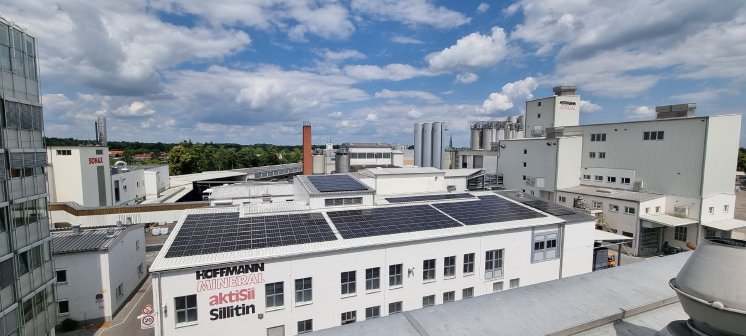The agenda of energy-related and environmental measures taken by HOFFMANN MINERAL is extensive and includes both short- and long-term arrangements. Numerous items have already been implemented, not least a cogeneration plant in Neuburg. A photovoltaic system will also be installed soon at the corporate group’s SONAX site in Oberhausen. With the considerably more comprehensive photovoltaic project in Neuburg, HOFFMANN MINERAL has now made by far the largest investment in its energy transition.
HOFFMANN opens a significant new chapter in its energy transition using photovoltaics
The photovoltaic project in Neuburg involved meticulous planning. After careful consideration of various renewable energy sources, such as hydro power or wind energy, this solution, which is effective in the short term, was deemed suitable for this project. It took only a few months from the planning of the PV system to its commissioning.
It is envisaged that electricity is generated from solar energy over many decades. In contrast, the company can expect a return on the investment at Münchener Straße after a mere seven years. This period, which is short for an investment of this magnitude, is due to the high consumption rate at HOFFMANN MINERAL. Thanks to the energy-intensive systems at the Neuburg site, the company can use around 95 % of the generated photovoltaic electricity for its own needs. It is anticipated that only 5 % of the energy generated will be fed into the power grid. This percentage rate relates mainly to the periods when the system is not in use, such as weekends. To ensure grid stability, the local network operator may, if required, obtain external access and thus enable the public power grid to remain functional at all times through so-called grid-supporting management. It remains to be seen if this proves to be necessary someday.
A total of 2,302 modules with 425 Wp (watt-peak) each were installed parallel to the roof without additional mounting. The flat structure is attached with approx. 4.6 kilometres of mounting rails and extends over an overall surface area of 4,495 m². The four subsystems with 978.35 kWp generate a maximum inverter output of 891 kW. The solar energy generated is expected to save 15,890 tonnes of CO2 as early as within the initial 25 years.


